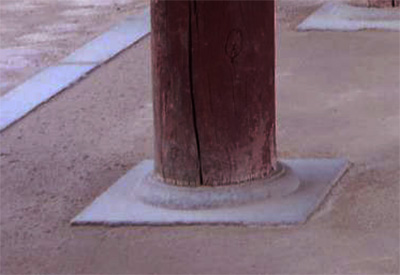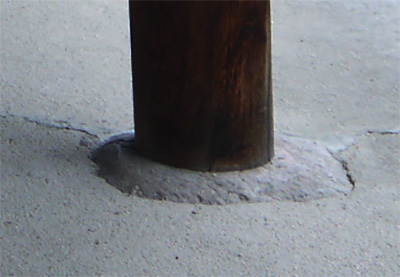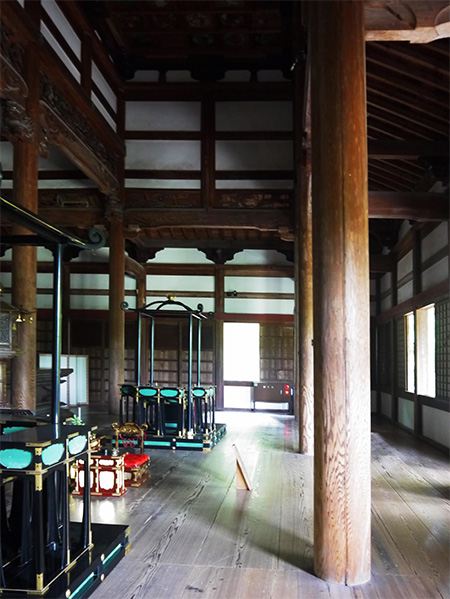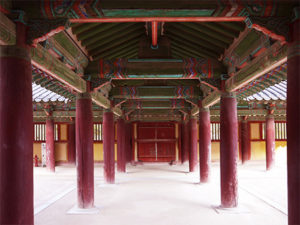


昨日、根来寺の「亀腹」に触れました。
基壇という架構ベースになる平面は大陸から導入された木造概念。
その基壇が和風化していくなかでさまざまに建築が変容した実相をみた。
北海道で「高断熱高気密」という住宅の作りようの革命が起こったけれど、
より巨視的に見ると木造というもの自体、日本の社会・風土条件に即して
古代から休むことなく変容し,進化していることが実感できる。
逆に日本の木造技術進化のひとつのプロセスが高断熱高気密化だったのでしょう。
こういう「故きを温ねて新しきを知る」ことほど喜ばしい体験もない。
現代の機械化・合理化の過程でさまざまな革新が一気に表出しているけれど、
実は古代でもそういう創意工夫は連綿と続いてきた。
実に深く「教えられる」ことが多く、ワクワクさせられる。
中国には天の象徴が丸で、地の象徴は角と言う
「天円地角」の思想があるという。
天に通
ずる柱は丸、地に密着した礎石は角(方)との「円柱方礎」が起こった。
わが国では柱は丸が圧倒的だが礎石は角
にとらわれず適当な自然石が用いられた。
上の写真は上が大陸の影響の強い韓国仏国寺の円柱と方形の礎石。
下は仏国寺よりも150年ほど古い創建年代の法隆寺の回廊部分の円柱と礎石。
その下写真は根来寺の「亀腹」上に配置された礎石と束柱の様子。
最古級の仏教寺院建築においてすでに日本人はオリジナリティを示している。
たぶん大陸、半島からの木造技術者はかれらの「正調」を主張しただろうけれど
その時代の日本の「在来」伝統工法の木造技術者たちは和様を対置した。
中国出自の「観念論」からの木造技術に対して明確に否定したのでしょう。
大陸国家は常に専制独裁であり特定の観念を他に強制するのに対して
海洋国家であり自然崇拝志向が優先するわが国建築文化としては
「和を以て貴しとなす」という民主主義が機能したように思える。
礎石の方形加工を潔しとせず、あるがままの石を利用した。
法隆寺ではほぼ自然石に近い円形の礎石が採用されていますね。
たぶん寺院建築指導する大陸から派遣の技術者の説く観念論に対して
同意することができず、八百万の自然信仰ベースが反応したのではないか。
また、日本の柱材は着色されず素木のままに使われていることが多い。
法隆寺の柱類はほぼ無着色・素木という素材表現。
こちらは根来寺・伝法堂の内陣領域の円柱。


一方この写真は半島国家仏国寺の回廊部の着色ぶり。
針葉樹の桧、杉などは建築の材料としては最適。良材の得られない国土や地域では
木材に彫刻や彩色をする伝統が優勢になるが、良材がふんだ
んに得られるわが国では
素木そのものが装飾材であるという木造文化が主流になる。
究極的には伊勢神宮のように素木で再生させ続けるという「美感」文化を生んだ。
これはやはり海洋に囲まれて温暖・多雨気候条件から豊かな森林がある、
そういった日本の国土条件が育んだ木造への審美眼なのではないか。
仏教建築において彼我の相違が顕著にあらわれている。
English version⬇
[Chinese “Cylindrical Foundation” and Japanese Architecture Kishu Negoroji-5]
Yesterday, I touched the “turtle belly” of Negoroji Temple.
The plane, which is the base of the frame, is a wooden concept introduced from the continent.
As the foundation became Japanese, we could see the fact that the architecture changed in various ways.
There was a revolution in Hokkaido to build a house called “high heat insulation and high airtightness”.
Looking at the big span, the wooden structure is also in line with the social and climate conditions of Japan.
You can feel that it has been transformed and evolved since ancient times.
On the contrary, one process of the evolution of Japanese wooden technology would have been high heat insulation and high airtightness.
There is no more pleasing experience than “warming the old and knowing the new”.
In the process of modern mechanization and rationalization, various innovations are appearing at once,
In fact, even in ancient times, such ingenuity continued.
It’s really exciting to be “taught” very deeply.
It is said that in China, the symbol of heaven is a circle, and the symbol of the earth is a horn.
There, the pillar leading to the heavens was a circle, and the cornerstone that was in close contact with the ground was a “cylindrical cornerstone” with a corner. It was
In Japan, the pillars are overwhelmingly round, but the cornerstones are not limited to the corners and appropriate natural stones are used. It was
The photo above shows the pillars and square cornerstones of the Korean Bulguksa Temple, which is strongly influenced by the continent.
Below are the columns and cornerstones of the corridor of Horyuji Temple, which was founded about 150 years older than Bulguksa Temple (605).
The photo below shows the cornerstones and pillars placed on the “turtle belly” of Negoroji Temple.
The Japanese have already shown their originality in the oldest Buddhist temple architecture.
Perhaps wooden engineers from the continent and peninsula claimed their “right”
The wooden engineers of the Japanese “conventional” traditional construction method of that era faced the Japanese style.
Perhaps he clearly denied the wooden technique from the “idealism” of Chinese origin.
Whereas continental nations are always tyranny and enforce certain ideas
As a maritime nation and prioritizing nature worship, Japan
It seems that the democracy of “being precious with harmony” worked.
The square processing of the cornerstone was not made clean, and the stone as it was was used.
At Horyuji Temple, a circular cornerstone that is almost like a natural stone is used.
Probably against the idealism of the technician dispatched from the continent to teach
I couldn’t agree and the eight million nature worship bases might have reacted.
In addition, Japanese pillars are often used as bare wood without being colored.
The pillars of Horyu-ji are almost uncolored and are made of bare wood.
This is a column in the inner camp area of Negoroji Temple and Denpodo.
On the other hand, this photo shows the coloring of the corridor of Bulguksa Temple on the peninsula.
Coniferous cypress and cedar are the best materials for construction. In countries and regions where good materials are not available
The tradition of carving and coloring wood becomes predominant, but in Japan, where good wood is abundantly available.
The wooden culture that the bare wood itself is a decorative material becomes mainstream.
Ultimately, it created a “beauty” culture of continuing to regenerate with bare wood like Ise Jingu.
It is also surrounded by the ocean and has abundant forests due to warm and heavy rainfall climatic conditions.
Isn’t it an aesthetic eye for wooden structures that have been nurtured by such Japanese land conditions?
It seems that the difference is noticeable in Buddhist architecture.
Posted on 11月 18th, 2021 by 三木 奎吾
Filed under: 住宅マーケティング, 日本社会・文化研究, 歴史探訪







コメントを投稿
「※誹謗中傷や、悪意のある書き込み、営利目的などのコメントを防ぐために、投稿された全てのコメントは一時的に保留されますのでご了承ください。」
You must be logged in to post a comment.